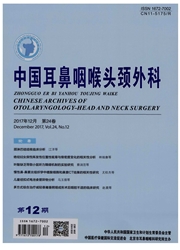

 中文摘要:
中文摘要:
目的建立化学性嗅觉功能障碍的大鼠动物模型,观察电刺激嗅觉诱发电位(olfactory evoked potentials,OEPs)的特点及变化规律。方法腹腔注射300 mg/kg 3-甲基吲哚对SD大鼠造成嗅上皮的损伤,动态观察给药后不同时间点(1 h、3~6 h和24 h)的OEPs变化。结果电刺激嗅黏膜时在嗅球附近可记录到"负-正-负(N1-P1-N2)"的三相波,当刺激电流为3 mA时,潜伏期和振幅分别为N1波12.9 ms/19.1μV,P1波23.6 ms/27.0μV,N2波41.7 ms/15.1μV。给药后1 h OEPs变化无显著性;3~6h后OEPs出现变化,表现为N1波或N1、N2波消失,其潜伏期明显延长及振幅变小;以上改变在给药后24h更加显著。结论腹腔注射3-甲基吲哚可建立SD大鼠急性嗅觉障碍的模型,该模型操作简单且重复性好。
 英文摘要:
英文摘要:
OBJECTIVE To develop an animal model of chemical induced olfactory dysfunction and to investigate the characteristics of electrically stimulated olfactory evoked potentials(OEPs).METHODS The animal model was set up by intraperitoneal injection of 300mg/kg 3-methylindole(3-MI).The changes of OEPs in SD rats were observed at 1 hour,3-6 hours and 24 hours after intraperitoneal administration of 3-MI.RESULTS Triphasic waves(negative- positive- negative),named N1,P1,N2 respectively,were recorded.The latencies and amplitudes of N1,P1,N2 were 12.9 ms/19.1 μV,23.6 ms/27.0 μV and 41.7 ms/15.1 μV.After administration of 3-MI 1 hour,the changes of OEPs were not significant.After 3 hours,the OEPs changed as N1 vanished,or N1 and N2 both vanished.The latency was extended obviously and the amplitude decreased significantly.The changes were more obviously after 24 hours.CONCLUSION Intraperitoneal injection of 3-MI could establish an animal model of acute olfactory dysfunction.It was a simple and reproducible method.
 同期刊论文项目
同期刊论文项目
 同项目期刊论文
同项目期刊论文
 A New Microfluidic Chip-Based Online Electrochemical Platform for Extracellular Neurochemicals Monit
A New Microfluidic Chip-Based Online Electrochemical Platform for Extracellular Neurochemicals Monit In vivo ratiometric Zn2+ imaging in zebrafish larvae using a new visible light excitable fluorescent
In vivo ratiometric Zn2+ imaging in zebrafish larvae using a new visible light excitable fluorescent A simple and versatile microfluidic cell density gradient generator for quantum dot cytotoxicity ass
A simple and versatile microfluidic cell density gradient generator for quantum dot cytotoxicity ass Colorimetric and Fluorescent Dual Mode Sensing of Alcoholic Strength in Spirit Samples with Stimuli-
Colorimetric and Fluorescent Dual Mode Sensing of Alcoholic Strength in Spirit Samples with Stimuli- A multi-enzyme microreactor-based online electrochemical system for selective and continuous monitor
A multi-enzyme microreactor-based online electrochemical system for selective and continuous monitor An H2O2-responsive nanocarrier for dual-release of platinum anticancer drugs and O-2: controlled rel
An H2O2-responsive nanocarrier for dual-release of platinum anticancer drugs and O-2: controlled rel Continuous and Simultaneous Electrochemical Measurements of Glucose, Lactate, and Ascorbate in Rat B
Continuous and Simultaneous Electrochemical Measurements of Glucose, Lactate, and Ascorbate in Rat B Statistical single-cell analysis of cell cycle-dependent quantum dot cytotoxicity and cellular uptak
Statistical single-cell analysis of cell cycle-dependent quantum dot cytotoxicity and cellular uptak Online monodisperse droplets based liquid-liquid extraction on a continuously flowing system by usin
Online monodisperse droplets based liquid-liquid extraction on a continuously flowing system by usin Strategy for signaling molecule detection by using an integrated microfluidic device coupled with ma
Strategy for signaling molecule detection by using an integrated microfluidic device coupled with ma Platinum(II)-Gadolinium(III) Complexes as Potential Single-Molecular Theranostic Agents for Cancer T
Platinum(II)-Gadolinium(III) Complexes as Potential Single-Molecular Theranostic Agents for Cancer T Single-molecule dynamics of site-specific labeled transforming growth factor type II receptors on li
Single-molecule dynamics of site-specific labeled transforming growth factor type II receptors on li Visualization of the post-Golgi vesicle-mediated transportation of TGF-beta receptor II by quasi-TIR
Visualization of the post-Golgi vesicle-mediated transportation of TGF-beta receptor II by quasi-TIR Interfacing Microsampling Droplets and Mass Spectrometry by Paper Spray Ionization for Online Chemic
Interfacing Microsampling Droplets and Mass Spectrometry by Paper Spray Ionization for Online Chemic High-throughput and automatic typing via human papillomavirus identification map for cervical cancer
High-throughput and automatic typing via human papillomavirus identification map for cervical cancer A portable microchip for ultrasensitive and high-throughput assay of thrombin by rolling circle ampl
A portable microchip for ultrasensitive and high-throughput assay of thrombin by rolling circle ampl A mitochondrion-targeting copper complex exhibits potent cytotoxicity against cisplatin-resistant tu
A mitochondrion-targeting copper complex exhibits potent cytotoxicity against cisplatin-resistant tu A turn-on fluorescent Fe3+ sensor derived from an anthracene-bearing bisdiene macrocycle and its int
A turn-on fluorescent Fe3+ sensor derived from an anthracene-bearing bisdiene macrocycle and its int Visualization and quantification of neurochemicals with gold nanoparticles: Opportunities and challe
Visualization and quantification of neurochemicals with gold nanoparticles: Opportunities and challe Water-Stable, Adaptive, and Electroactive Supramolecular Ionic Material and Its Application in Biose
Water-Stable, Adaptive, and Electroactive Supramolecular Ionic Material and Its Application in Biose An in vitro liver model on microfluidic device for analysis of capecitabine metabolite using mass sp
An in vitro liver model on microfluidic device for analysis of capecitabine metabolite using mass sp Aggregation-Induced Structure Transition of Protein-Stabilized Zinc/Copper Nanoclusters for Amplifie
Aggregation-Induced Structure Transition of Protein-Stabilized Zinc/Copper Nanoclusters for Amplifie Assay of multiplex proteins from cell metabolism based on tunable aptamer and microchip electrophore
Assay of multiplex proteins from cell metabolism based on tunable aptamer and microchip electrophore Nanoscale imaging with an integrated system combining stimulated emission depletion microscope and a
Nanoscale imaging with an integrated system combining stimulated emission depletion microscope and a Internalization of the TGF-beta type I receptor into caveolin-1 and EEA1 double-positive early endos
Internalization of the TGF-beta type I receptor into caveolin-1 and EEA1 double-positive early endos Online electrochemical systems for continuous neurochemical measurements with low-potential mediator
Online electrochemical systems for continuous neurochemical measurements with low-potential mediator 期刊信息
期刊信息
